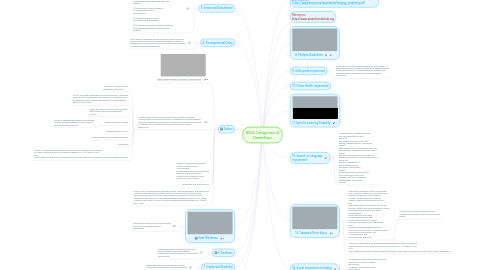
1. INTERVENTION: for other severe orthopedic impairment that adversely affects a child's final performance. (http://www.tcsea.org/downlaods/helping_students.pdf)
2. 5. Emotional Disturbance
2.1. Exhibiting one or more of the following characteristics over an extended period of time: (a) An inability to learn that cannot be explained by intellectual, sensory, or health factors. (b) An inability to build or maintain satisfactory interpersonal relationships with peers and teachers. (c) Inappropriate types of behavior or feelings under normal circumstances. (d) A general pervasive mood of unhappiness or depression. (e) A tendency to develop physical symptoms or fears associated with personal or school problems.
3. 4. Developmental Delay
3.1. This is defined differently by each state but involves a delay in one or more of these areas: physical development; cognitive development; communication; social or emotional development; or adaptive behavior development
4. Deaf-Blindness
4.1. Simultaneous hearing and visual impairment resulting in decreased academic performance
5. Autism
5.1. https://www.youtube.com/watch?v=d4G0HTIUBlI
5.2. Developmental disability significantly affecting verbal, nonverbal communication and social interaction. Characteristics include repetitive activities & stereotyped movements, resistance to environmental change or change in daily routines, and unusual responses to sensory experiences.
5.2.1. TREATMENT: Early Intensive Behavioral Intervention
5.2.2. Just as your child’s challenges can’t be summed up in one word, they can’t be remedied with one therapy. Each challenge must be addressed with an appropriate therapy. No single therapy works for every child.
5.2.3. Parent Education & Training: Train parents to give autistic child social & behavioral training
5.2.4. Cognitive Behavior Therapy
5.2.4.1. Works on changing how thinking is processed. Reduce challenging behaviors & recognize & face feelings that may arise.
5.2.5. Applied Behavior Analysis
5.2.6. Sensory Integration/Occupational Therapy
5.2.7. Medication
5.2.8. Citation: "Intervention Research for Students with LD | Especially for Teachers | At School." National Center for Learning Disabilities. N.p., n.d. Web. 03 Nov. 2014. <http://www.ncld.org/students-disabilities/ld-education-teachers/intervention-research-students-with-ld>.
5.3. Memory - especially rote memory Superior academic skills Visual thinking Recognizing order and following rules Have passion and conviction Comfort and compatibility with adults rather than children
5.4. Remarkable Skill with Autistics:
5.5. CASE STUDY: Comprehensive Synthesis of Early Intensive Behavioral Interventions for Young Children with Autism Based on the UCLA Young Autism Project Model --- Reichow, Brian, and Mark Wolery. "Comprehensive Synthesis of Early Intensive Behavioral Interventions for Young Children with Autism Based on the UCLA Young Autism Project Model." Journal of Autism and Developmental Disorders 39.1 (2009): 23-41. Web.
6. 3. Deafness
6.1. Hearing impairment to the point that it also impairs linguistic processing without amplification. Adversely affect's child's school performance.
7. Reference: http://www.parentcenterhub.org
8. 7. Intellectual Disability
8.1. subaverage intellectual functioning, existing concurrently with deficits in adaptive behavior and manifested during the development period
9. 6. Hearing Impairment
9.1. compromised ability to hear, whether permanent or fluctuating
10. 8. Multiple Disabilities
11. 9. Orthopedic Impairment
11.1. INTERVENTION: 1) maintain good auditory environment 2) use of technology (ex. cochlear implants for hearing impaired 3) test hearing daily 4) provide preferential seating 5) also provide written instructions to go along with spoken instructions
12. 10. Other Health Impairment
13. 11. Specific Learning Disability
14. 12. Speech or Language Impairment
14.1. sequencing (e.g., breaking down the task, providing step-by-step prompts); drill-repetition-practice (e.g., daily testing, repeated practice, sequenced review); segmentation (e.g., breaking down skills into parts and then synthesizing the parts into a whole); directed questioning and responses (e.g., teacher asks process or content questions of students); control of task difficulty; use of technology (e.g., computers, presentation media); teacher-modeled problem solving; small-group instruction; and strategy cues (e.g., reminders to use strategies, think-aloud models).
15. 13. Traumatic Brain Injury
15.1. Intervention Strategies: Select a meaningful goal or skill the student will need to learn and present it at the level of the student; Provide a simple rationale to help the student understand the relevance of the skill; Give clearly stated task directions (limit the number of steps) and ask the student to repeat or paraphrase the directions to ensure understanding; Break tasks into small steps and demonstrate each step; Provide opportunities for student response and practice at an appropriate pace; Provide immediate feedback and error correction when necessary—feedback should be positive and systematic; and Use verbal praise and encouragement frequently.
15.1.1. Case Study: Classroom Interventions for Students with Traumatic Brain Injuries (See link below)
